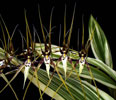|
|
|
|
|
| |
Flasks of
Brassia arcuigera 'Clack' × 'Variegata' |
|
| |
|
|
| |
| Number: |
TN2113 |
| Name: |
Brassia arcuigera 'Clack' × 'Variegata'
|
| |
Very LOW yield
|
| Type: |
outcross (What's that?) |
|
Seed Donor: |
Dale Borders
|
|
Click to Enlarge

Pod Parent Flowers |
Click to Enlarge

Pollen Parent Flowers and Leaves |
Click to Enlarge

Pollen Parent Capsules at 215 days |
|
|
|
| |
Culture Notes from Donor: Parent plants: Temperature range I (60-83°F)
Comments: For the genus, flowers are very pleasantly scented.
For additional origin/habitat information supplied courtesy of
Charles and Margaret Baker, see further below, near the bottom of this page.
|
Temperatures we attempt to use in the lab & greenhouse:
| For Species: |
|
Summer, Autumn, Winter, Spring: days average 77°F, nights 64°F; best fit is Intermediate 83-60°F
(Source:
Baker's Web OSC) |
|
About the name...
| Etymology of |
arcuigera |
|
From Latin "arcuiger" bow-carrying. With a bent flower raceme.
(Source:
Mayr & Schmucker 1998) |
| Etymology of |
Brassia |
|
Named for William Brass, British botanical illustrator of the 19th century.
(Source:
Pridgeon 1992) |
| Pronunciation of |
Brassia |
|
BRAS-ee-ah
(Source:
Pridgeon 1992) |
|
If you would like to direct someone to this web page, please copy and paste this URL into your email:
http://troymeyers.com/d?012113
| Flask Information |
| Availability: |
We had yield problems with this item, so we didn't continue flasking it. |
| You should: |
Consider placing a "Notify Retries" Request, and if an identical pollination (the same parents) is done again, we'll let you know. |
|
You might also want to:
|
View the seed assay for this item.
View items of the same species.
View items of the same genus.
|
|
|
| |
The origin/habitat information below is supplied courtesy of Charles and Margaret Baker
The following information is based on the name of the plant provided by the donor, and assumes that the name is correct. If the plant has been misidentified, then the following information may not be correct.
This text is copyrighted by the Bakers and may not be reproduced without permission.
ORIGIN/HABITAT: Costa Rica, Panama, Colombia, Venezuela, Ecuador, and
Peru. In Costa Rica, numerous collections are reported on the Pacific side
of the isthmus in the Provinces of Alajuela and Guanacaste. In Alajuela
Province, plants grow from near sea level to 3150 ft. (0–960 m). In
Guanacaste Province, they were found at 1950–3950 ft. (600–1200 m). In
Panama, plants grow on Pacific side of the isthmus in the Provinces of
Coclé and Veraguas at 3000–3400 ft. (910–1040 m) and northeast of Panama
City in Panama Province at 2600–3950 ft. (800–1200 m). In Ecuador, plants
are found on the western slopes of the Andes in the Provinces of Canar,
Chimborazo, Cotopaxi, Napo, and Pichincha at 1650–3300 ft. (500–1000 m).
Plants usually grow on moss-covered trees in cloudforests or wet,
lower-elevation rainforests. In Venezuela, this orchid (as Brassia
rhizomatosa) is found between Duaca and Agua Fría. In Colombia, it grows
at 3300–5900 ft. (1000–1800 m). This is the only information available
about the habitat in Venezuela and Colombia, and no information was
available for the Peruvian habitat.
More about this information and the Bakers...
|
|
|
| |
|
|
|